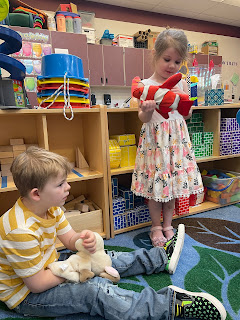Transition Song: This Is The Way We Go To Sleep by Super Simple Songs
(Note: this song is a great way to help establish a bedtime routine.)
Vocabulary and Basic Concepts: happy, sad, scared, worried, problem solving, sit, on, chair, cow, dog, pig, cat, mouse, environmental sounds, yes/no, not, help, "I want _____".
This week Miss Carrie read the book What Will Fat Cat Sit On? by Jan Thomas.
The animals have a problem they have to solve. What will Fat Cat sit on? The cow? The chicken? The pig? The dog? Someone comes up with a solution (just like we do at school). Everyone has to agree to the solution (just like we do at school). Does everyone agree? Did Fat Cat agree? We noticed the feelings of each animal and talked about worried, sad, happy, and mad.
Miss Carrie introduced us to George.
George LOVES to sit on kid's heads. George loves to give hugs. BUT.....George also knows that it might cause a problem if he tries to sit on a head or give hugs when someone does not want to do that. George knows how to solve the problem. He asks first. "Can I sit on your head?" Silly George! Friends can answer yes or no. Sometimes, George asks "Can I hug you?" Again friends could answer yes or no. If the answer is no, we have to listen and honor that. Everyone was laughing, including George, when he sat on someone's head.
Then everyone got a puppet. We could ask our friends the same questions. We had to listen for Yes or No.
 |
| HUGS! |
DO THIS AT HOME: Practice asking questions and answering yes/no. You could also problem solve with other daily activities. Such as: "We have a problem! We need to eat dinner, but the table isn't set. What can we do to solve the problem?" Practicing solving easy problems that are already part of your daily routine will help foster understanding for the harder problems that are not within your daily routine. Such as: Your child wants to go to the park. But we don't have time for the park today. We have to go to the grocery store. What can we do to solve the problem? Let everyone offer answers. Sometimes, you have to give your child a choice of two things that you are willing to let them choose. We can't go to the park, we can choose to go tomorrow, or we can choose an extra book tonight before bed. We have to go to the grocery store. Do you want to choose apples or oranges at the store for a snack at home? Practice answering yes/no questions. Be sure to ask questions where you can honor the "no" answer, such as Do you want to read this book? -or- Do you want to wear the red shirt?











